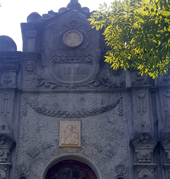
Century-old palace suffers gross architectural violations under the Patriarchate’s ownership
By Levan Abramishvili
Monday, August 26
Another building which belongs on the list of the cultural heritage of Georgia is being destroyed under the ownership of the Georgian Orthodox Church. After Kintsvisi and Timotesubani medieval churches, the palace in the village of Sujuna, Abasha Municipality, is under danger.
For several days, the information was spread on social media that the castle, which currently belongs to the Georgian Patriarchate has been damaged as a result of gross architectural interventions. The Information about the arbitrary actions have been confirmed by the Agency for Cultural Heritage Protection. However, the Patriarchate states that the monument’s condition has not deteriorated, but has improved.
Georgian entrepreneur Akaki Khoshtaria built the palace in the village of Sujuna over 100 years ago. According to the Agency, it has the status of cultural heritage monument since 2014.
According to the information spread on social media, the monument is being prepared to be the residence of an archbishop. “A unique relief was removed from the building and the process of gross reconstruction is underway,” reads the Facebook post.
An online publication ‘Netgazeti’ writes that they got in touch with the Agency to check the information spread on social media. According to their press office, the building has been the property of the Patriarchate for 10 years already. The agency has confirmed that there had been interference in the monument in the past. In particular, four years ago, in 2015, relief was removed from the façade of the building. Shortly afterward an investigation was launched into the case and an agency employee was also questioned.
“We do not know by whom, but this building was under the severe architectural influence, there were instances of improper interference,” the Agency said. As for the current situation and the reports that the monument is still being damaged, the Agency said that the monitoring team would study the situation on the spot.
The interference the agency is talking about is obvious. The relief of an ogre appears on the façade of the building in a picture taken by the Radio Liberty in 2015. The photos taken recently show that the relief has been removed and replaced with religious icons.
‘Netgazeti’ was told by the Ministry of Internal Affairs that the investigation launched 4 years ago is under Article 259, which implies damage or destruction of cultural heritage, is still underway. Since 2015, it has not become evident who is responsible for damaging the monument.
According to the press office of the Patriarchate, the information spread on social media “does not fully reflect the truth”.
“The palace in Sujuna was not handed over to the Patriarchate, as it was said, but it was auctioned ten years ago,” writes the head of the press office of the Patriarchate Andria Jaghmaidze on Facebook.
“The palace was indeed in terrible condition, it was being damaged by running water, before being sold. As a result of the work done by the Diocese so far, the situation has been partially improved,” reads the post. According to him, interior rehabilitation works are also planned on in agreement with the Agency.
According to ‘Netgazeti’, speaking to ‘Radio Atinati’, Bishop of Abasha Cathedral Konstantine Kacharava also denied the alleged change of the original façade of the building, as well as plans to transform it into a residence. As to why relief was removed, the cleric said the figure was damaged and was on the verge of collapse.
“As Kacharava tells us, that's why they decided to replace it with St. George's relief,” ‘Radio Atinati’ reports.
The Cultural Heritage Protection Agency also says that 10 years ago the building was in poor condition, water was running, damaging the historic interior. According to the Agency, after the building was transferred to the Patriarchate, a corridor built during the Soviet era, linking the palace to a local school, was demolished, since it was not a part of the original project. They also replaced the roof from where the water was going in and the door, which the agency said was also damaged.
According to the Agency, shapes and materials that were used when replacing the roof and the door were authentic and identical of the original, but the Patriarchate did not obtain permission from the Agency, because at the time the palace was not a cultural heritage monument. Therefore, the Agency’s specialists did not oversee the process.
“We have an agreement to organize a memorial house-museum of Akaki Khoshtaria in the future. With the involvement of the Agency and the Diocese, the concept will be created. The rehabilitation process in the future will be based on that as well,” the Agency said.
Born near Abasha in 1873, in a noble family, Akaki Khoshtaria was a Georgian entrepreneur, socialite, and philanthropist. He owned several assets in Tbilisi, sponsored cultural establishments in Georgia and provided scholarships for Georgian students to study abroad. He built the castle in Sujuna village in 1915. According to the locals he spent most of his time abroad, therefore the house was built for his mother. During the Russian Revolution of 1917, he was close to pro-independence revolutionaries in Georgia. After the fall of the Democratic Republic of Georgia to a Bolshevik invasion in 1921, Khoshtaria emigrated to Paris, where he died in 1932 and was buried at the Père Lachaise Cemetery.



